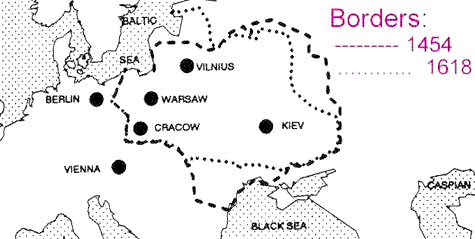

Cont'd.
|
In the reaffirmation of 1334, King Casimir III the Great decreed: |
... we ... wish to bring to the attention of all persons ... that ... certain of our Jews from our realm ... showed a privilege given to them by the most serene Duke Boleslaus of happy memory ... we have considered the privilege and its statutes with the exhaustive deliberation of our royal majesty ... and have not found ... anything which should displease our majesty ... we order and command the renewal ... declaring it acceptable, pleasing, and firm. |
|
Eastward migrations continue
The "aforesaid Casimir" continued
Eighty-six years later, in 1539, Sigismund I [The Great], and third son of Casimir IV, ratified the Charter still again, at the request of "certain duly appointed elder Jews." King Casimir's 1453 re-ratification, "written on parchment ..." had been presented to King Sigismund and was found to be "intact throughout." And so King Sigismund ordered it recopied,
|
|
The Fortress of Poznan,
according to Pogonowski, is
where the recopied version of the 1264 Charter ratified by King Sigismund in 1539
is preserved. The civil liberties it memorializes were key to the
flourishing of the Jews.
Left: Until 1764, Poland's kings were
coronated at Wawel Castle
From confederation to
commonwealth 1588 Statute of the Great
Dukedom of Lithuania
1588 Statute ... Part 12, Article 7 If a knight is convicted of either killing or robbing a Jew and has neither a homestead nor does service for anyone, but instead plays the dice and drinks, then even if he were not caught at the place of the crime, he must be beheaded...If a Jew or a Jewess has converted
to Christianity, then they and their descendants must be treated as
knights.... |
|
When the monarchy was strong, Jewish rights were acknowledged and the most effectively protected. From the Charter of 1264 until the first partition of Poland in 1772 is a huge segment of history compared with the comparatively short history of the United States: from 1776 to the present. That makes particularly notable the long stretches during this period, especially prior to the 17th century, when Jewish life was nurtured and prospered. However, as the power and influence of the Catholic clergy grew, conditions for Jews worsened, and the region sunk into disarray. |
 |
|
Poland's golden age ends As a country, Poland was obliterated. Russia found itself with an enormous population of Jews which it did not want. Its response was to create the "Pale of Settlement." The Pale restricted Jews to the western portion of Russia, which consisted largely of the lands it had annexed from Poland and Lithuania. Restrictions and deteriorating conditions made the 19th century profoundly miserable for Jews there. A wave of pogroms that began in 1881 spurred emigration to the United States and elsewhere. |
![]()